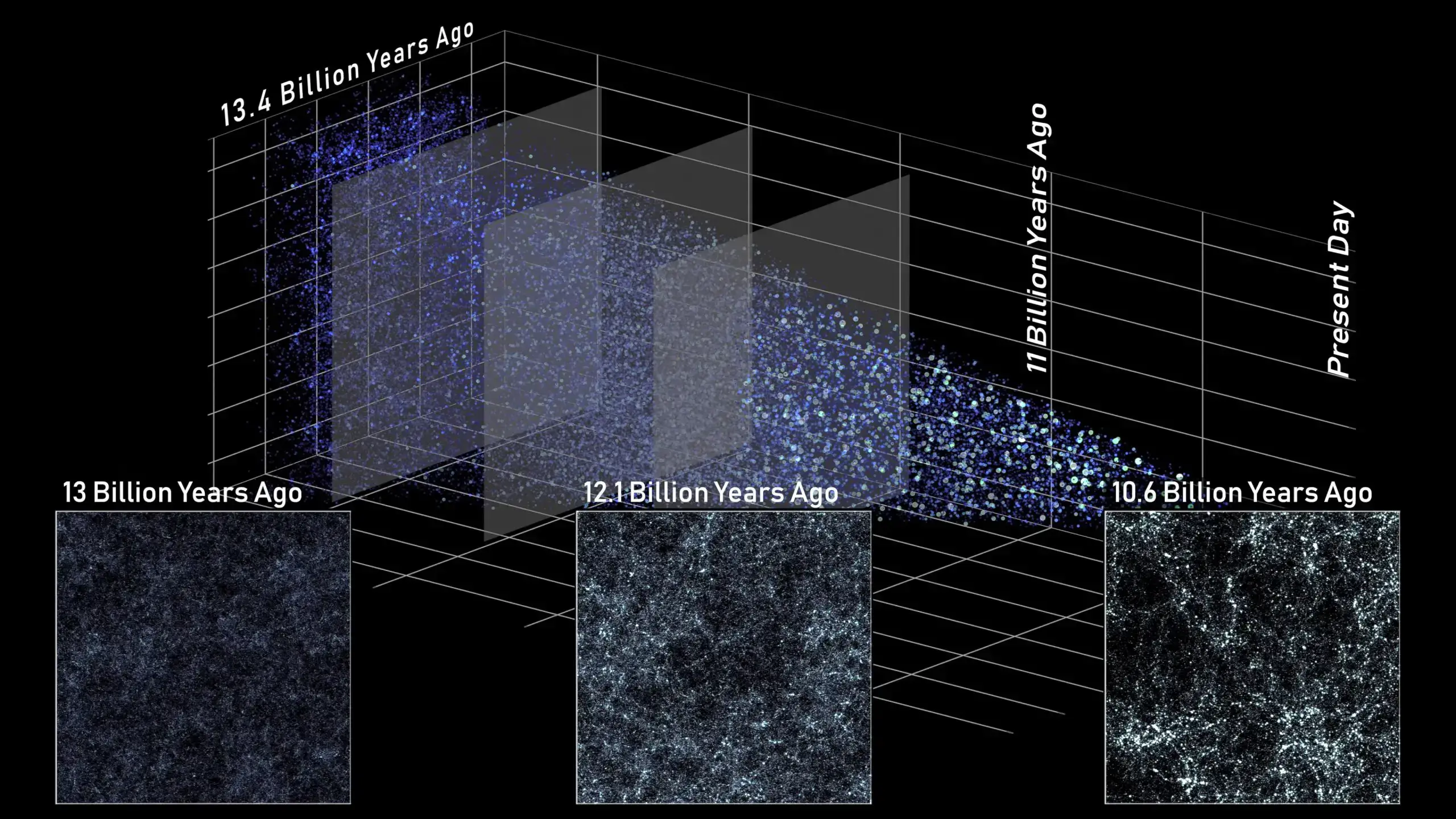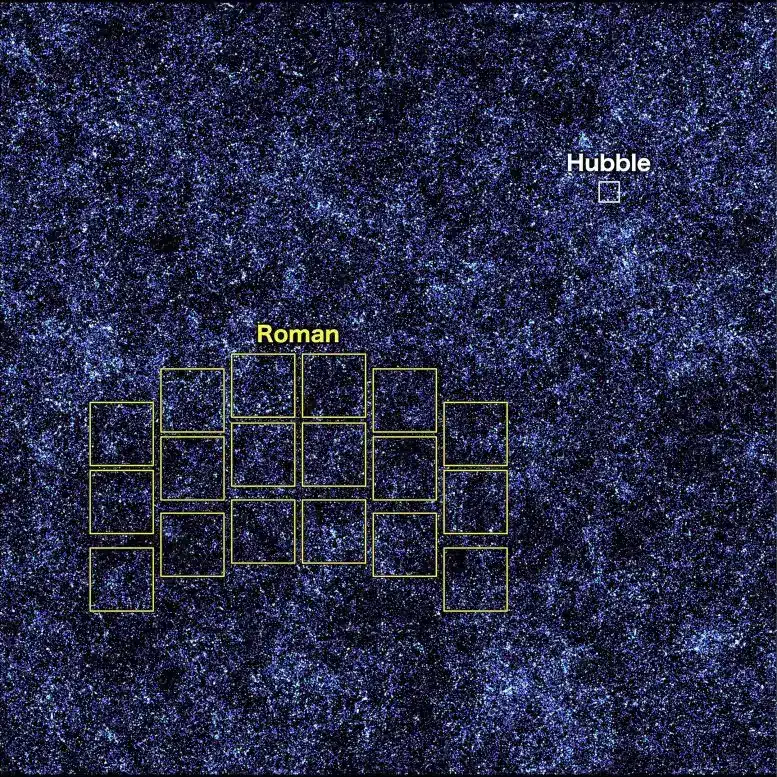Through its ability to rapidly image vast swathes of space, Roman will help us understand how the universe changed from the Julian water of charged particles to the complex network of large cosmic structures we see today.

A new visualization shows how NASA's Nancy Grace Roman Space Telescope, to be launched in May 2027, will turn back the cosmic clock and reveal the evolving universe in ways never before possible. Through his ability to rapidly image vast swathes of space, Roman will help us understand how the universe changed from the Julian water of charged particles to the complex web of large cosmic structures we see today.
"The Hubble and James Webb space telescopes are optimized to study astronomical objects deeply and closely, so they look at the world through pinholes," said Aaron Jung, a postdoctoral researcher at NASA's Goddard Space Flight Center in Greenbelt, Maryland, who led the study. "To solve cosmic mysteries on the largest scale, you need a telescope that can provide a much larger view. This is exactly what Roman is designed to do."
The combination of Roman's large view with Hubble's wider wavelength coverage and Webb's more detailed observations will allow for a more comprehensive view of the universe.

The simulation covers a two-square-degree patch of sky, which is roughly ten times the apparent size of a full moon, and contains more than five million galaxies. It is based on a very well-established model of galaxy formation that represents our current understanding of how the universe works. Using a very efficient technique, the team can simulate tens of millions of galaxies in less than a day - compared to years with the usual methods. When Roman launches and starts sending real data, the scientists will be able to compare it to a variety of such simulations, putting their models to the ultimate test. This will help solve the physics of galaxy formation, dark matter - a mysterious substance that can only be observed through its gravitational effects - and many other things.
Galaxies and galaxy clusters glow in clumps along invisible filaments of dark matter in a carpet the size of the observable universe. Taking a wide enough view of this tapestry, we can see that the large-scale structure of the universe resembles a web, with strands stretching across hundreds of millions of light-years. Galaxies are mostly found at intersection points of the filaments, with "empty cosmic spaces" between all the glowing filaments.
This is what the universe looks like today, but if we could rewind the universe, we would see something very different.
Instead of huge burning stars sparsely scattered in galaxies separated by even greater distances, we find ourselves immersed in a sea of plasma (charged particles). This July soup was almost completely uniform, but luckily there were tiny knots. These clumps were slightly thicker than their surroundings, so their gravitational pull was slightly greater.
Over hundreds of millions of years, the clumps attracted more and more material to them. They grew large enough to form stars, which gravity pulled them into the dark matter that forms the invisible backbone of the universe. Galaxies were born and continued to evolve, and eventually planetary systems like our solar system appeared.
Roman's panoramic view will help us see what the universe was like at different stages and fill in gaps in our understanding. For example, astronomers have discovered "halos" of dark matter that surround galaxies, but they are not sure how they formed. By showing how dark matter-induced gravitational clouding envelops the appearance of more distant objects, Roman will help us see how haloes have evolved over cosmic time.
More of the topic in Hayadan:
- Higher, farther, earlier - scientists discovered a galaxy from the beginning of the universe
- Is a large concentration of dark energy at the beginning of the universe responsible for accelerating the expansion of the universe that began 7 billion years ago and is felt today?
- The race for matter since the beginning of the universe

3 תגובות
These articles are wise and make us marvel at the great nature and the great mind of man.
Many thanks to both researchers and publishers.
A rambling and confused article. How does the telescope work? What are wavelengths? And high words are not necessarily understood.
Layman's questions:
Fact: We are looking through a telescope at galaxy Z which is 13 billion light years away from us.
follows from the figure: the galaxy looks as it was 13 billion years ago from today.
Another fact: the same galaxy moves away from us at a proportionally higher speed than closer galaxies.
And another fact: one of the galaxies closest to us, 'Andromeda' is not moving away at all, but actually getting closer and "soon" will collide with the 'Milky'.
The conclusion of the world of science: the galaxies farther away from us are running away from us at higher and higher speeds, the universe is expanding at an accelerated rate and eventually all matter will disintegrate, the universe will get dark and it will be terribly cold here...
And these are my questions:
Maybe this conclusion is wrong?
Maybe the speed we diagnose with Z is a historical figure?
Maybe *today* Z is moving away from us at a smaller speed?
Maybe she doesn't move away at all?
Perhaps, like Andromeda, Z is also rushing towards us?
Bottom line: maybe the universe is contracting and we're going back to *another* big bang?
last question:
Is it possible that only a complete layman (and unaware) would dare to raise such questions?
I would very much appreciate an answer... of any kind...
Thanks in advance.